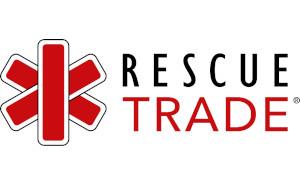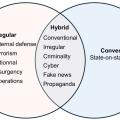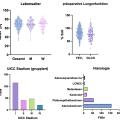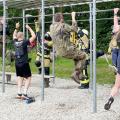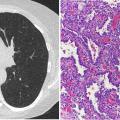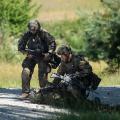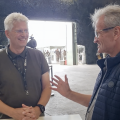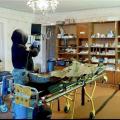The 9th DiMiMED Conference was held in Duesseldorf, Germany, on 15th and 16th November. This year’s event was a ‘physical’ event, as opposed to last year’s entirely virtual event. As ever, DiMiMed was held in association with MEDICA, the Medical Industry Trade Fair, which this year was also a ‘physical’ event.
Having endured the constraints associated with the COVID-19 pandemic for nearly two years, it made a very pleasant change to meet old friends ‘in the flesh’ and make new ones. The ongoing presence of COVID-19 was marked by the usual precautions e.g. requirement to provide proof of vaccination or recovery from infection, social distancing in the Conference Room during presentations and breaks, mask wearing and the practice of regular hand hygiene. The hand shake was replaced by the elbow bump! None of these necessary public health precautions, however, interfered with, or lessened, the typical camaraderie of attendees, the enthusiasm of the presenters for their topics, access to the speakers, or the standards of the presentations. One of the unforeseen benefits of COVID-19 was the free-flowing traffic in the morning which ensured that travel by shuttle bus to the Messe from the Conference Hotels was not as protracted an experience as in the past. In all, there were 156 delegates from 27 different countries in attendance.
Mr Erhard Wienkamp welcomed all the attendees to the Conference on behalf of Messe Duesseldorf. Following a brief Scientific Welcome Address given by the Chair and Co-Chair, the Opening Speech was delivered by Brig Gen Bruno Most. The Conference was then addressed by the COMEDS Chairman, BG Dr Zoltan Bubenik who delivered the Key Note Speech.
The Opening Module of the Conference was entitled ‘Hot Topics in Disaster and Military Medicine’, jointly chaired by the Chair and Co-Chair, and consisted of presentations on: (i) the Low Incidence of COVID-19 in Sub-Saharan Africa and speculation at to why this is the case; (ii) the potential that currently is available to use the Soldier as a Sensor; (iii) gunshot wounds to the brain with positive and negative prognosticators; (iv) the ever improving potential for identification from human remains of the identity of victims of trauma; (v) the revamped military-medicine.com website incorporating the digital almanac, the digital military-medicine journal, military-medicine interviews as well as an upcoming events page.
The Second Module of the day was on CBRN and was Chaired by Col Dr Dirk Steinritz. Under Dirk’s stewardship presentations were delivered on: (i) Therapy and Verification of Poisoning by Organophosphorous Compounds; (ii) CBRN Medical Countermeasures; (iii) Nanotech Strategies for Repairing Chemically Injured Skin; (iv) Miniaturized Electrochemical Biosensors for Smart Detection of Chemical & Warfare Agents; (v) Tunisian Deployment and Missions during the COVID-19 Pandemic; and (vi) Contribution of Medical CBRN Defence to Combat the COVID-19 Pandemic.
The Third and Final Module of the first day of the Conference was on Infectious Diseases and was Chaired by Dr Benjamin Queyriaux. Benjamin has organized a very interesting programme which included (i) The Promise of New Vaccine Platforms; (ii) An update on Takeda’s new Dengue Vaccine; (iii) UK Armed Forces Vaccination Policy in response to COVID; (iv) Immunization schedule of the Polish Armed Forces; (v)’Preventing the Unpredictable – a Chikungunya Vaccine Candidate’; (vi) New Vaccines in the Pipeline for the Operational Soldier.
The Second Day’s programme opened with the ‘Disaster Medicine’ Module chaired by Dr John Quinn. John had organised speakers on the following topics: (i) A Typology for the Civil-Military Response to COVID-19; (ii) Mobile Detection Kits for Nerve Agents and Other Acteylcholinesterase Inhibitors; (iii) Ventilation and Oxygen Supply Equipment; (iv) Health Security Threats and NATO Interoperability; and (v) Point of Injury Care in the Post COVID-19 World.
The second Hot Topics in Disaster and Military Medicine module consisted of presentations on (i) Nerve Agent Incident is Salisbury; (ii) Novel Transport Portable Ventilator for the Military Environment and (iii) Why and How Health and Wellbeing must be on every CHOD’s Agenda.
The Final Module of the Conference was devoted to Mental Health and was organized and Chaired by Col Dr Eric Vermetten. The opening presentation was on “Tackling Trauma with Technology – 3MDR for Military Members and Veterans with PTSD.” This was followed by a presentation on Psychotropic Medication Use in the Armed Forces. The next presentation asked whether the existing Disaster Mental Health Knowledge Base was Applicable to COVID-19. The title of the next presentation was Psychosocial Care Responses in Terrorist Attacks. This was followed by two virtual presentations, the first being on 10 Key Principles in Mental Well Being and the second on Grief Leadership and COVID.
Following some Closing Remarks by the Chairman, all attendees were invited to visit the MEDICA Trade Fair, and 9th DiMiMED International Conference on Disaster and Military Medicine was formally closed.
Wehrmedizin und Wehrpharmazie 4/2021
G. Kerr/H. Lange
Beta Verlag GmbH

